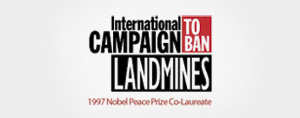27 November 2013
Landmine Monitor Launch Press Release 2013
PRESS RELEASE 10:00 (GMT+1) 28 November 2013
Dramatic drop in landmine casualties, lives saved as clearance and funding reach new peaks; yet antipersonnel mine use by Yemen and a small number of states and armed groups must be urgently addressed
Francais, Espanol, Arabic
(Geneva, 28 November 2013): Records were set in 2012 for the lowest number of new reported casualties, largest amount of landmine-contaminated land cleared, and highest level of global funding for mine action, according to Landmine Monitor 2013, the latest annual report of the International Campaign to Ban Landmines, released today in Geneva.
“The continued decline in new casualties indicates just how successful the 1997 Mine Ban Treaty has been in fulfilling its vital promise of ending the harm caused by these weapons,” said Jeff Abramson, final editor of the report and program manager for Landmine and Cluster Munition Monitor. “The rate of 10 casualties per day for 2012 is less than half of what was reported when the Monitor started recording casualties in 1999 of approximately 25 casualties each day,” he added.
In 2012, casualties caused by mines, victim-activated improvised explosive devices, cluster munition remnants, and other explosive remnants of war (ERW) decreased to a global total of 3,628 compared with 4,474 in 2011, marking the lowest level since 1999.
The use of antipersonnel mines has also dramatically declined as a result of the Mine Ban Treaty, but has not abated completely. Most disturbing is new evidence in 2013 that forces loyal to the government of Yemen—a Mine Ban Treaty member state—laid thousands of antipersonnel mines in 2011. The mine use in Yemen is the first confirmed use of antipersonnel mines by a treaty member state (also known as a “State Party”). Additionally, allegations of antipersonnel mine use persist in States Parties South Sudan, Sudan, and Turkey.
Under the treaty, States Parties are prohibited from using, producing, stockpiling, or transferring antipersonnel mines. The mine use at Bani Jarmooz in Yemen has caused at least 15 civilian casualties. In total, there were 263 recorded landmine/ERW casualties in the country in 2012, compared to just 19 in 2011.
“States Parties are obligated to investigate use of antipersonnel mines and hold those responsible for violations accountable,” said Mark Hiznay, senior researcher at Human Rights Watch and ban policy editor of Landmine Monitor 2013. “Yemen also needs to take immediate action to clear the mines and prevent further casualties.”
Government forces in two states not party to the treaty—Syria and Myanmar—used antipersonnel mines in 2012 and 2013. Non-state armed groups (NSAGs) in Afghanistan, Colombia, Myanmar, Pakistan, Syria, Thailand, Tunisia, and Yemen used antipersonnel mines in 2013, the highest number of countries with NSAG use in the past five years. Military forces in the disputed area of Nagorno-Karabakh also used antipersonnel mines in 2013.
Record clearance and support
In 2012, a record high of at least 281km2 of mined areas were released through clearance or survey—up from at least 190km2 in 2011—destroying almost 240,000 antipersonnel mines. In addition, some 245km2 of battle areas were cleared in 2012—up from at least 233 km2 in 2011. Over the past decade, almost 1,981km2 has been released through clearance or survey and more than 3.3 million mines removed from the ground.
Under Article 5 of the treaty, States Parties must clear all known mined areas on their territory within 10 years. Five states declared clearance completion in 2012 (Republic of Congo, Denmark, Gambia, Jordan, and Uganda) and at least three more are expected to announce completion at next week’s Meeting of States Parties (Bhutan, Hungary, and Venezuela).
In 2012, donors and affected states contributed approximately US$681 million in international and national support for mine action, the largest combined total ever recorded and $19 million more than in 2011. International donor funding alone was a record $497 million, an increase of $30 million as compared with 2011.
In addition, the UN General Assembly provided more than $113 million in 2012 for mine action in nine peacekeeping operations—a 25% increase compared with 2011. Not all states, however, increased their support for mine action. Twenty donors contributed less in 2012 than they did in 2011, with Canada’s one-year decrease of more than $10 million resulting in the lowest annual contribution by Ottawa since the Mine Ban Treaty was signed in 1999.
Additional key findings from the report include:
- With Poland’s ratification of the Mine Ban Treaty on 27 December 2012, there are now 161 States Parties to the treaty, including all European Union member states. ·
- Collectively, 87 States Parties have destroyed more than 47 million stockpiled antipersonnel mines, including more than 250,000 destroyed in 2012. However, Belarus, Greece, and Ukraine remain in violation of the treaty after having failed to complete the destruction of their stockpiles by their four-year deadline.
- Since 2009, significant progress has been made in victim assistance as measured against the commitments States Parties made that year through the Cartagena Action Plan, but challenges remain in making sure programs are available and sustainable, especially in remote areas.
Landmine Monitor 2013 will be released on 28 November by the International Campaign to Ban Landmines in advance of the Mine Ban Treaty’s Thirteenth Meeting of States Parties, taking place at the United Nations in Geneva from 2–5 December. More detailed state-specific information is available in online country profiles, while the overviews in the report provide global analysis and findings. The report focuses on calendar year 2012, with information included up to October 2013 in some cases.
ENDS
About the Monitor:
Landmine and Cluster Munition Monitor is the research arm of the International Campaign to Ban Landmines - Cluster Munition Coalition (ICBL-CMC). The ICBL was awarded the 1997 Nobel Peace Prize for its work to eradicate landmines. The Monitor is coordinated by a Monitoring and Research Committee comprised of ICBL-CMC expert staff, research team leaders, and representatives of four non-governmental organizations: Handicap International, Human Rights Watch, Mines Action Canada, and Norwegian People’s Aid.
Links:
- Landmine Monitor 2013 (as of 28 Nov) - http://www.the-monitor.org/lm/2013
- Detailed individual country profiles - http://www.the-monitor.org/cp
- ICBL website - http://www.icbl.org/
- Mine Ban Treaty - http://www.apminebanconvention.org/
- ICBL Facebook - http://www.facebook.com/minefreeworld
- ICBL Twitter - https://twitter.com/minefreeworld
- ICBL Flickr - http://www.flickr.com/photos/minefreeworld/collections/
- ICBL Youtube - http://www.youtube.com/user/ICBLnetwork
- Landmine and Cluster Munition Monitor Twitter - https://twitter.com/MineMonitor
For more information or to schedule an interview, contact:
• Jared Bloch, ICBL-CMC Media and Communications Manager, Geneva (GMT+1), mobile +41-78-683-4407, +41-22-920-03-20, or email jared@icblcmc.org
• Jeff Abramson, Landmine and Cluster Munition Monitor Program Manager, Geneva (GMT+1), mobile +41-77-436-94-11 or email jeff@icblcmc.org



